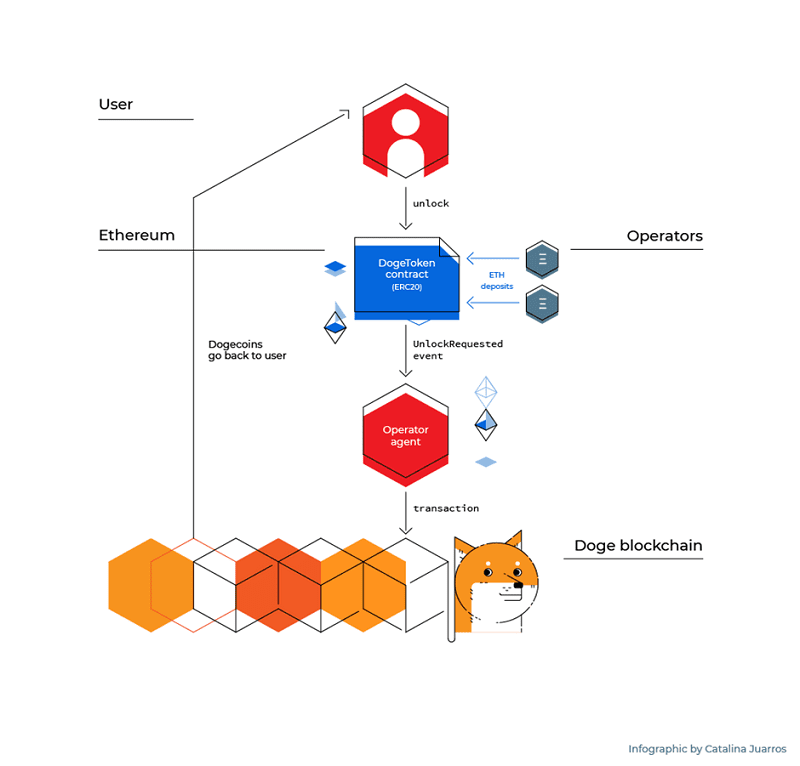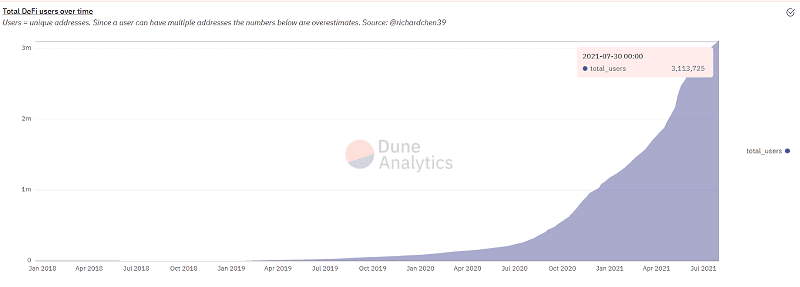A significant event happened recently but went largely unnoticed by much of the crypto community as most traders were focused on Bitcoin’s phenomenal recovery. This involved Ethereum (ETH)’s founder, Vitalik Buterin, and two Dogecoin (DOGE) developers, Ross Nicoll and Oscar Guindzberg. The trio went live in a video conference as confirmation that the much-requested DOGE-ETH Bridge is now underway and development is cruising along well. This project was initiated in 2018 by DOGE developers but was shelved indefinitely during the crypto-winter of 2019. However, ever since ETH’s founder Vitalik Buterin and Elon Musk proposed for the two influential coins to work together in June this year, the project has been restarted and has been progressing along great.
Buterin’s appearance as a form of support is important since he is an influence to ETH and the crypto community. His support of the project makes it especially legitimate and feasible.
So, what is this DOGE-ETH Bridge about?
To put simply, a DOGE-ETH bridge allows DOGE to be used on all ETH-based platforms. A bridge allows holders of DOGE, which currently has no smart contract capability, to be able to utilise their DOGE to join the ETH metaverse which comprises a growing list of revolutionary innovations from financial to new economic systems. Basically, this means holders of DOGE will be able to participate in ETH-based DeFi, NFT, Gaming, DAO, etc.
This bridge works by allowing DOGE to be locked onto a smart contract which then mints an equivalent amount representing it on the ETH blockchain (via the ERC-20 token standard). It basically lets you create an ETH-version of DOGE that you can use just like ETH, and thereafter, returns you your DOGE back in its full DOGE glory after you finish doing what you wanted to do at an ETH-based platform and want your DOGE back.
While it certainly is great news for DOGE, this could be even better news for ETH. In order to not make this article too long, I shall not go into the details of how the bridge process works (you can read the flow-diagram below).

Diagram depicting the mechanics of the Doge-Eth Bridge, taken from Github
The key thing to note is that the way this bridge functions, at least in its current form, requires the usage of ETH as gas fee and also, ETH to be placed as collateral for participants who wish to become the “guardian” to aid in the smooth process of this “in-and-out transformation”. Instead of having a centralised entity oversee the locking and unlocking of DOGE, the entire process is done via smart contract that will be governed by a series of “guardians” called Bridge Operators. To become a bridge operator, a participant needs to place some ETH as collateral. This process is somewhat similar to the ETH staking at ETH2.0 where validators will need to put up ETH as collateral to secure the new PoS network. And just like the validators at ETH2.0, these bridge operators will be paid a reward.
Hence, this bridge could increase the usage of ETH in terms of gas fee payable, but not only this, it also reduces the circulating supply of ETH since bridge operators will need to lock up their ETH. While the details of the ETH lock-up is not yet available, it invariably is going to cause demand for ETH to increase and market supply of ETH to fall. The launch of this bridge will inevitably worsen the already serious supply crunch in ETH, thereby driving up its price even further with time. This newly created price catalyst comes on top of the current exciting developments within the ETH ecosystem that no longer needs any introduction.
It has been widely agreed that the phenomenal rise in ETH’s price over the past year has been driven primarily by the surge in popularity in the DeFi, NFT, and blockchain games arena where ETH remains the undisputed leader. Despite that market leader position, the number of users for DeFi, which accounts for more than 90% of ETH usage, stands only at around 3 million out of a world population of more than 7 billion – there is still plenty of room for growth.

It is also a wide-accepted fact that DOGE is the cryptocurrency with the highest number of unique holders, out of which the majority are new entrants to the crypto space who very likely may not have been exposed to ETH, much less, to the ETH ecosystem of DeFi and NFTs.
While it is difficult to ascertain the number of DOGE users, we can do a rough estimate via looking at social media numbers. There are currently more than 2.1 million subscribers in DOGE’s sub-reddit account, while its twitter account has more than 1.9 million followers – both metrics being the highest amongst any coin out there. The recent IPO filing for Robinhood has also demonstrated just how important DOGE has been to its business, with DOGE trades accounting for 34% of its crypto revenue in Q12021, up dramatically from only 4% the quarter before. Typically, seasoned crypto traders do not use Robinhood to make their crypto purchase as they normally do so on crypto-only exchanges. Hence, we can quite safely deduce that the majority of these DOGE buyers at Robinhood are new entrants to the cryptocurrency space in Q12021, and may have not been participating in DeFi nor NFTs.
Should this large group of new users come into the ETH-based platforms via the DOGE-ETH Bridge, the additional increment in the usage of ETH could be massive. DOGE’s friendly appeal has continuously been able to bring more new entrants into the crypto space as well-known consumer-centric companies like Slim-Jim and even Burger King have been incorporating the popular coin into their marketing campaigns, making it even more well-known. Hence, DOGE not only brings its current holders into the ETH ecosystem, it has the potential to bring in a lot more new users.
The bridge will likewise benefit DOGE greatly in that it creates an additional use case for DOGE which could increase demand, and more importantly, locks up some supply of DOGE when its replica-version-on-ETH is being used on various applications at ETH-based platforms. As more DOGE gets locked up for usage and/or yield generating purposes, the circulating supply of DOGE in the market will be reduced since these locked-up DOGE will not be available for sale, thus taking away selling pressure, which will be beneficial to price.
To conclude, this bridge is great news for ETH in that it can potentially bring in a great number of new entrants into the world of DeFi and NFT, while it gives DOGE holders the ability to participate in the world of decentralized finance, gaming, governance, and more, which is not readily available to DOGE holders currently.
The world’s most popular token (DOGE) working together with the world’s most utilised token (ETH) is a formidable combination that can potentially unleash even more explosive growth to two already highly-ranked cryptocurrencies.
Will the power of the DOGE be what ETH needs to send it soaring past BTC? And will the additional use case enabled by ETH send our favourite DOGE to the moon before the Dogefather does next January? I, like many others, can’t wait for the bridge to go live. This is an exciting development worth keeping an eye on. Both to the moon I would say.
About Kim Chua, PrimeXBT Market Analyst:
 Kim Chua is an institutional trading specialist with a track record of success that extends across leading banks including Deutsche Bank, China Merchants Bank, and more. Chua later launched a hedge fund that consistently achieved triple-digit returns for seven years. Chua is also an educator at heart who developed her own proprietary trading curriculum to pass her knowledge down to a new generation of analysts. Kim Chua actively follows both traditional and cryptocurrency markets closely and is eager to find future investment and trading opportunities as the two vastly different asset classes begin to converge.
Kim Chua is an institutional trading specialist with a track record of success that extends across leading banks including Deutsche Bank, China Merchants Bank, and more. Chua later launched a hedge fund that consistently achieved triple-digit returns for seven years. Chua is also an educator at heart who developed her own proprietary trading curriculum to pass her knowledge down to a new generation of analysts. Kim Chua actively follows both traditional and cryptocurrency markets closely and is eager to find future investment and trading opportunities as the two vastly different asset classes begin to converge.



















































